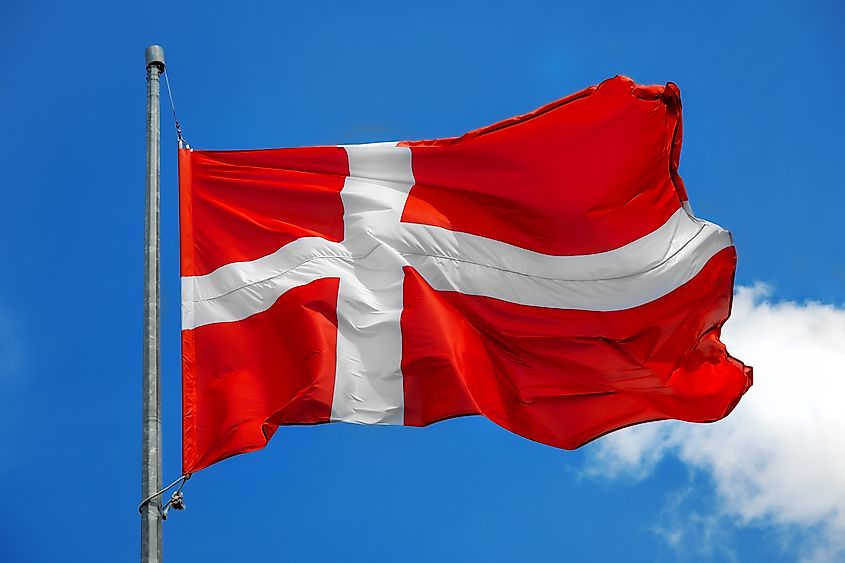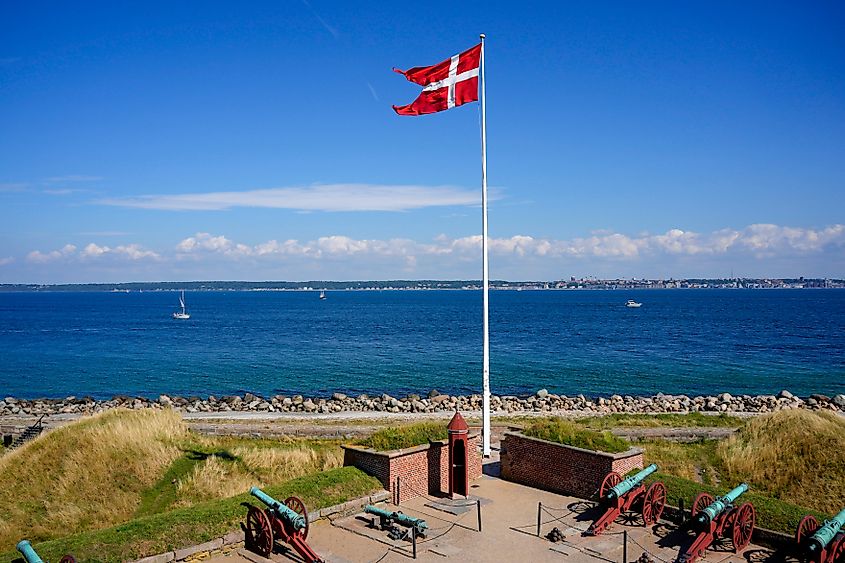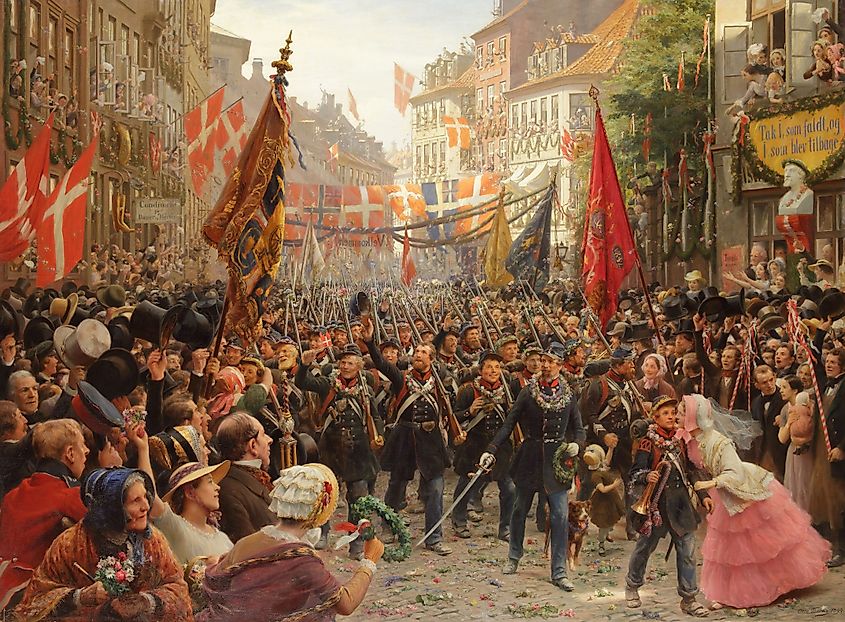
Which Is the Oldest Continuously Used National Flag?
- Adopted: Traditionally dated to June 15, 1219
- Legend: According to Danish legend, the flag miraculously fell from the sky during the Battle of Lyndanisse (now Tallinn, Estonia) and inspired Danish troops to victory.
- Design: A red field with a white Scandinavian cross extending to the edges; the vertical part of the cross is shifted toward the hoist side.
- Continuity: While many nations have redesigned their flags over time, Denmark has used the Dannebrog continuously for over 800 years, making it the world’s oldest national flag still in use.
The flag of Denmark, known as the Dannebrog, meaning “Danish cloth,” is recognized as the world’s oldest continuously used national flag. According to tradition, the Dannebrog dates back to 1219, when it is said to have miraculously fallen from the sky during the Battle of Lyndanisse. The simple yet striking design, a white Scandinavian cross on a red field became associated with Denmark centuries before many modern nations even existed.
Though official use of the rectangular flag was standardized in the 17th century, the symbol itself has endured for more than 800 years, making it a powerful emblem of Danish identity and history.
Description

Denmark’s flag features a white Scandinavian cross on a red field, with the cross extending to the edges and its vertical arm positioned toward the hoist side. In 1748, legislation formally defined the proportions of the Dannebrog as 28:34, though the length could be extended to 28:37 for certain uses. This regulation helped standardize the flag’s appearance after centuries of informal use, ensuring consistency across military, naval, and civic displays.
History of the Flag

The kings of Denmark are known to have used a red banner with a white cross as early as the 14th century, though the symbol itself likely predates that period. The white cross represents Christianity, a motif that later became common among the flags of other Nordic nations such as Sweden, Norway, Finland, and Iceland, each adopting its own variation of the “Nordic Cross” design.
According to legend, the Danish flag, known as the Dannebrog, miraculously fell from the sky during the Battle of Lyndanisse on June 15, 1219, in present-day Tallinn, Estonia. As the story goes, the flag appeared at a critical moment when the Danish forces, led by King Valdemar II, were close to defeat. Interpreted as a divine sign of victory, the sight of the flag is said to have rallied the troops and inspired them to triumph over the Estonian defenders.

While the legend remains central to Danish national identity, historians debate its origins. Some scholars suggest that the flag may have evolved from crusader banners used during the Northern Crusades, or that it was a gift from the pope symbolizing the church’s blessing of Denmark’s Christian campaigns in the Baltic. Flags bearing a white cross on red backgrounds were also common among Holy Roman Empire contingents, which may have influenced the Danish design.
Regardless of its true origin, the Dannebrog endures as a powerful emblem of faith, monarchy, and national continuity—a design that would later inspire the flags of nearly every Nordic country.
Symbolism

The Dannebrog’s simple design carries centuries of meaning that extend far beyond its red and white hues. The red field traditionally symbolizes bravery, strength, and the enduring spirit of the Danish people. The white cross, in contrast, stands for peace, honesty, and faith, reflecting the country’s Christian heritage and its later embrace of harmony and humanism as national ideals.
At its heart, the cross represents Christianity, a unifying emblem that ties Denmark to the broader family of Nordic nations. All Scandinavian flags share this cross motif, known as the Nordic Cross, a symbol of how Christianity spread across Northern Europe in the Middle Ages. Yet Denmark’s flag is distinct in that it was the first to bear this design, setting the template for others that followed.
Over time, the Dannebrog has come to embody not only religious faith but also national continuity and identity. It is flown proudly at state ceremonies, private homes, and even family celebrations—a rare instance of a national flag that is as much a personal emblem of joy as a state symbol. In this way, the red and white banner has evolved into a reflection of Danish unity, humility, and quiet pride—values that define the nation as much as the legend that gave birth to its flag.
Honorable Mentions
The Netherlands

The flag of the Netherlands, a horizontal tricolor of red, white, and blue, evolved over centuries from a symbol of rebellion to one of the world’s most influential flag designs. Its origins date to the late 16th century, during the Dutch Revolt (1568-1648) against Spanish rule. Early versions, known as the “Prince’s Flag” (Prinsenvlag), featured orange, white, and blue stripes—the colors of William of Orange, leader of the independence movement.
Over time, the top stripe gradually shifted from orange to deep red, likely because red dyes were more stable and visible at sea. This practical change was gradually accepted, and by the mid-17th century, the red-white-blue pattern had become standard among Dutch ships and military regiments. The design was formally confirmed as the national flag in 1937 by Queen Wilhelmina.
Beyond its own borders, the Dutch tricolor profoundly influenced the design of other nations’ flags, including those of France, Russia, and Luxembourg, which adapted its horizontal layout and color symbolism to their own national identities. Today, the flag stands as a symbol of liberty, maritime heritage, and republican tradition, reflecting the Netherlands’ enduring connection to independence and the sea.
Switzerland

Switzerland’s flag, a bold white cross on a red background, is one of the world’s most instantly recognizable national emblems. Its origins trace back to the 14th century, when Swiss soldiers from various cantons carried red banners marked with a white cross during the Battle of Laupen (1339). The cross served as a symbol of Christian faith and unity, distinguishing Swiss troops from their adversaries and reinforcing a sense of shared purpose among the confederated states.
For centuries, the design appeared in numerous local variations, often as a battle emblem or military ensign rather than a national flag. It was not until the mid-19th century, after the formation of the modern Swiss Confederation in 1848, that the square red flag with a centered white cross was formally adopted as the official national flag.
Today, the Swiss flag remains one of only two square-shaped national flags in the world (the other being that of the Vatican City). Its colors and proportions reflect neutrality, independence, and unity—values deeply woven into Switzerland’s national identity and international reputation. The red symbolizes freedom and bravery, while the white cross represents faith, peace, and the enduring humanitarian spirit that defines the Swiss Confederation.

